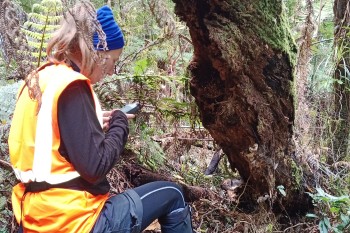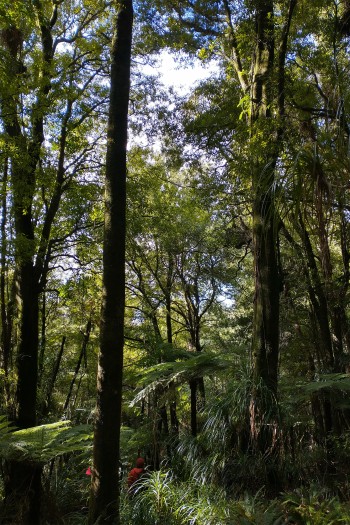
Recording a tītitipounamu/rifleman nest using GPS. The nest that the bird has made cosy by using feathers is on the underside of a dead log.
Dr Anne Schlesselmann and her Manaaki Whenua colleagues recently published the results of the first study to look for an elevational gradient in reproductive success for New Zealand birds in the New Zealand Journal of Ecology. The research, which is part of the MBIE Endeavour research programme ‘More Birds in the Bush’, looks at understanding the relationship between elevation and food supply for forest birds, and subsequent nest survival.
With native forest bird species in Aotearoa New Zealand under threat from introduced mammal predators such as possums, rats, and stoats, the ranges of many native forest bird species have contracted to cooler, higher-elevation tracts of forest that support fewer introduced mammals. However, while the birds are escaping predators, higher, cooler elevations have less food available, potentially leading to lower survival or breeding success.
Being able to determine the factors that limit populations in this way is therefore fundamental for effective conservation management of Aotearoa New Zealand’s threatened bird species. If places with optimal conditions can be identified, these can be targeted for predator control and lead to faster recovery of dwindling bird populations.

Typical tall tawa forest on Pirongia Mountain with a researcher at left observing a nest that shows the scale of the forest.
In spring and summer 2020/21, working at six sites at each of three different elevations on the sides of Pirongia Mountain, the researchers sampled invertebrate prey while simultaneously monitoring the fate of 55 tītitipounamu/rifleman (Acanthisitta chloris) nests and 33 miromiro/tomtit (Petroica macrocephala) nests, and the number of fledglings produced by each. Invertebrates were sampled on the ground and on the wing, and their biomass calculated. Camera traps and tracking tunnels were used to monitor predator numbers.
Mammal predators are routinely suppressed on Pirongia Mountain. Rats and possums do not only eat birds, but also the same food as native birds. Hence, only when rats and possums are at low numbers is it possible to investigate whether there are environments that are intrinsically more productive for birds, such as low-elevation forests.
The results from the 18 sites somewhat supported the theory that there would be less invertebrate food available for the birds at higher elevations and that their reproductive success would be lower as a result. In general, though, nest survival and number of fledglings produced by tītitipounamu and miromiro were not strongly related to elevation or food availability. Understanding differences in survival will be the next step to better understand food limitations.
“Studying food availability for birds is harder than studying predation and has been rarely done in New Zealand,” says co-researcher John Innes. “Yet we know from overseas research that birds make more nesting attempts when food is abundant.”
Anne says careful work such as this is the key to understanding likely habitat quality and bird population vulnerability to achieve thriving bird populations across the land.

